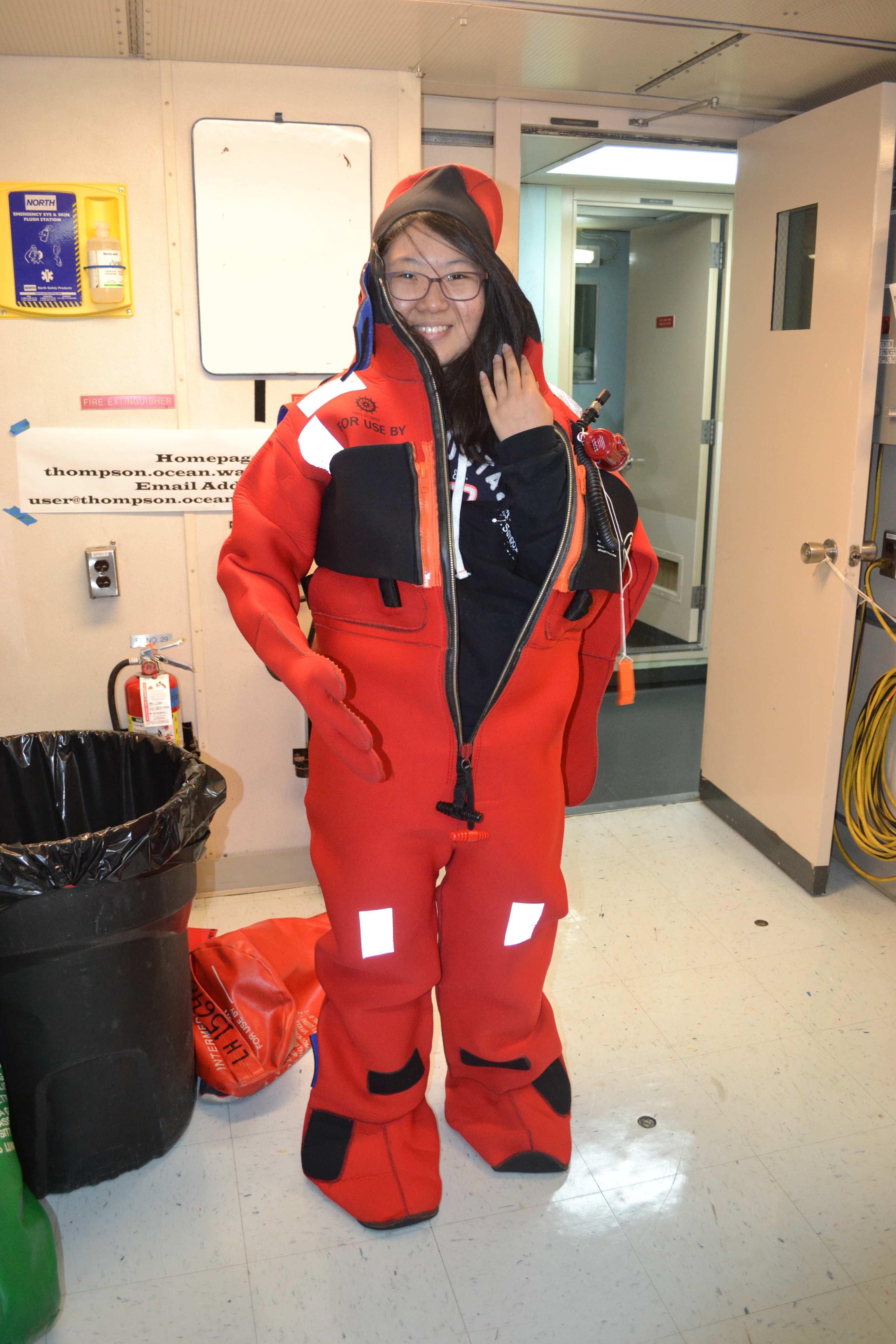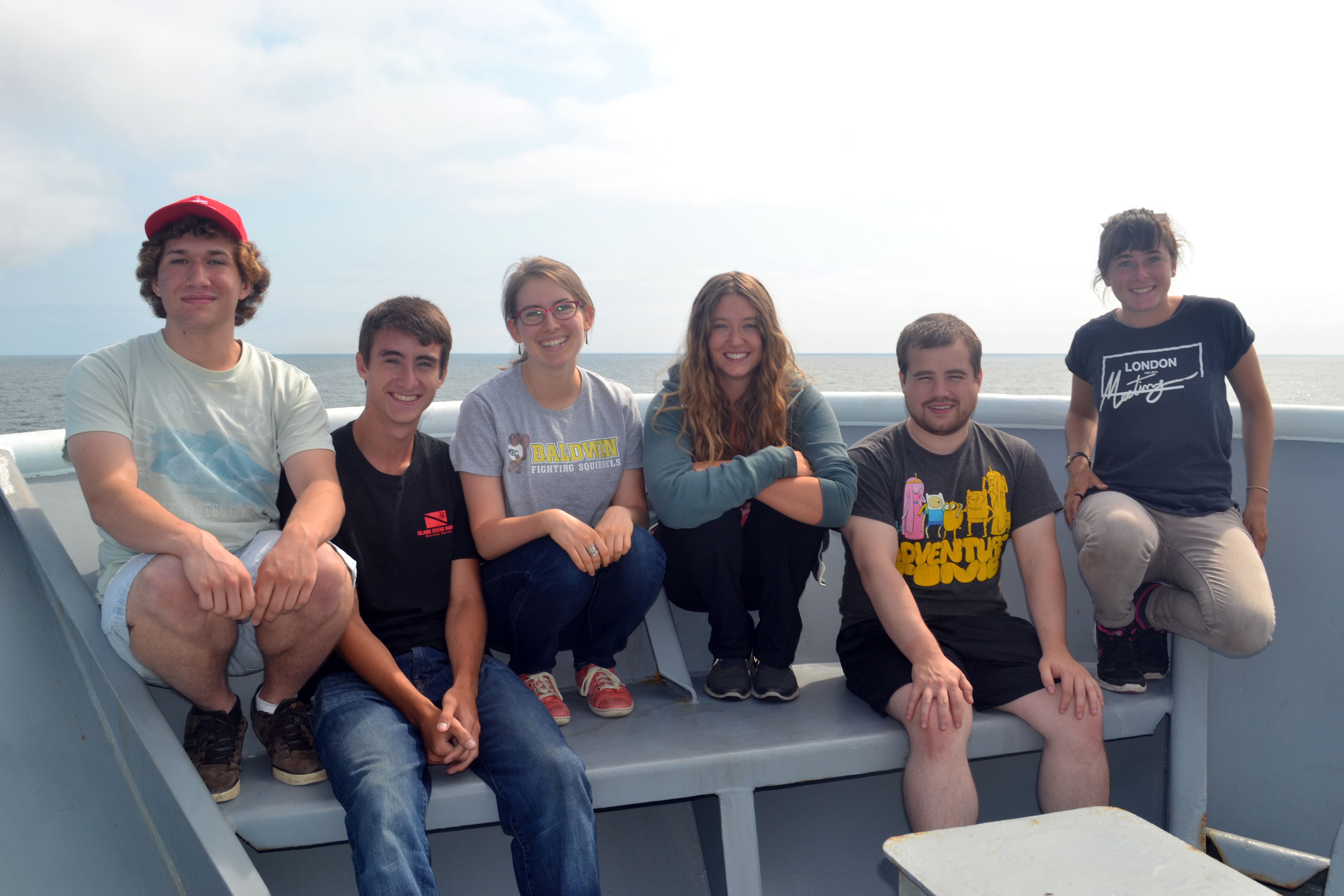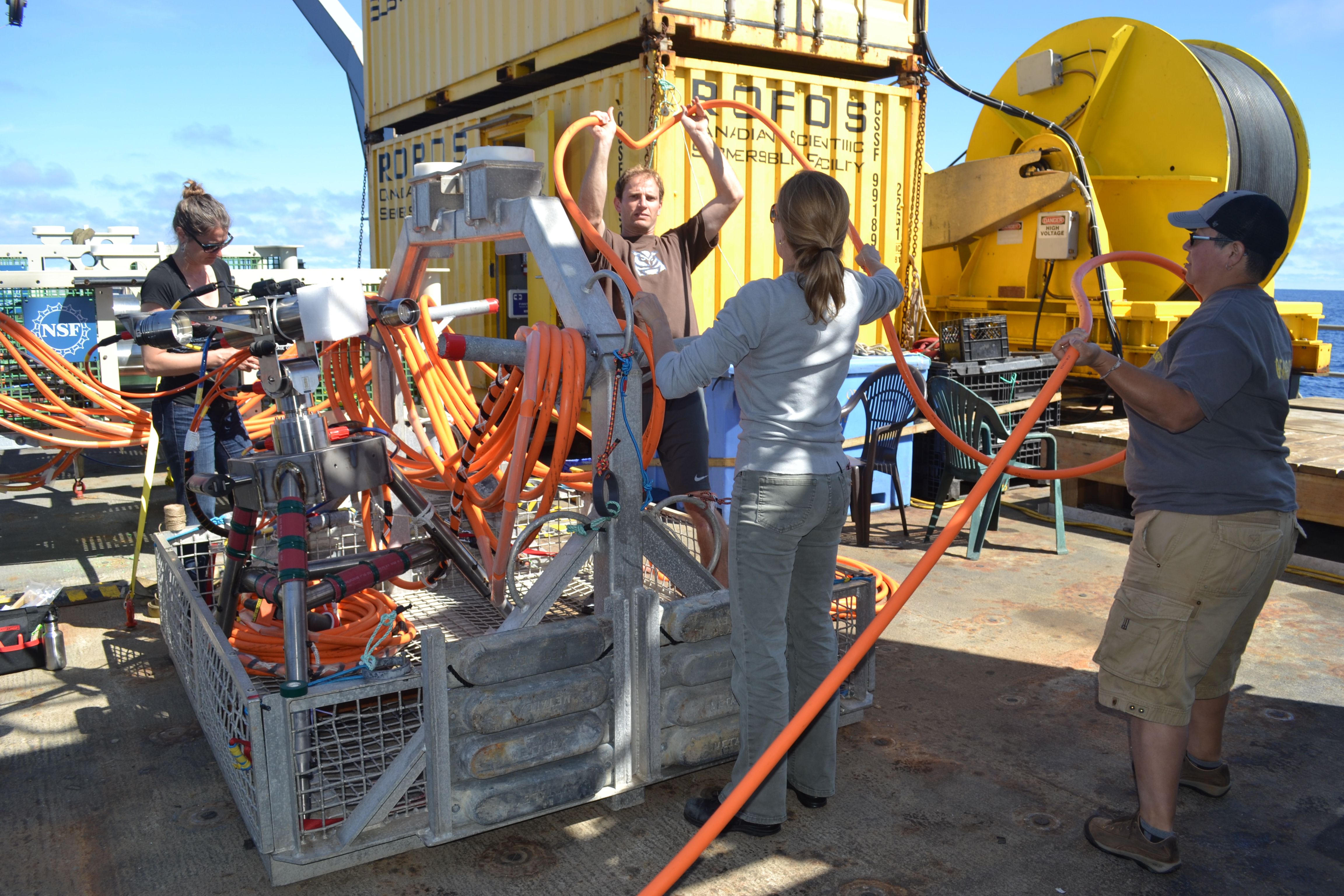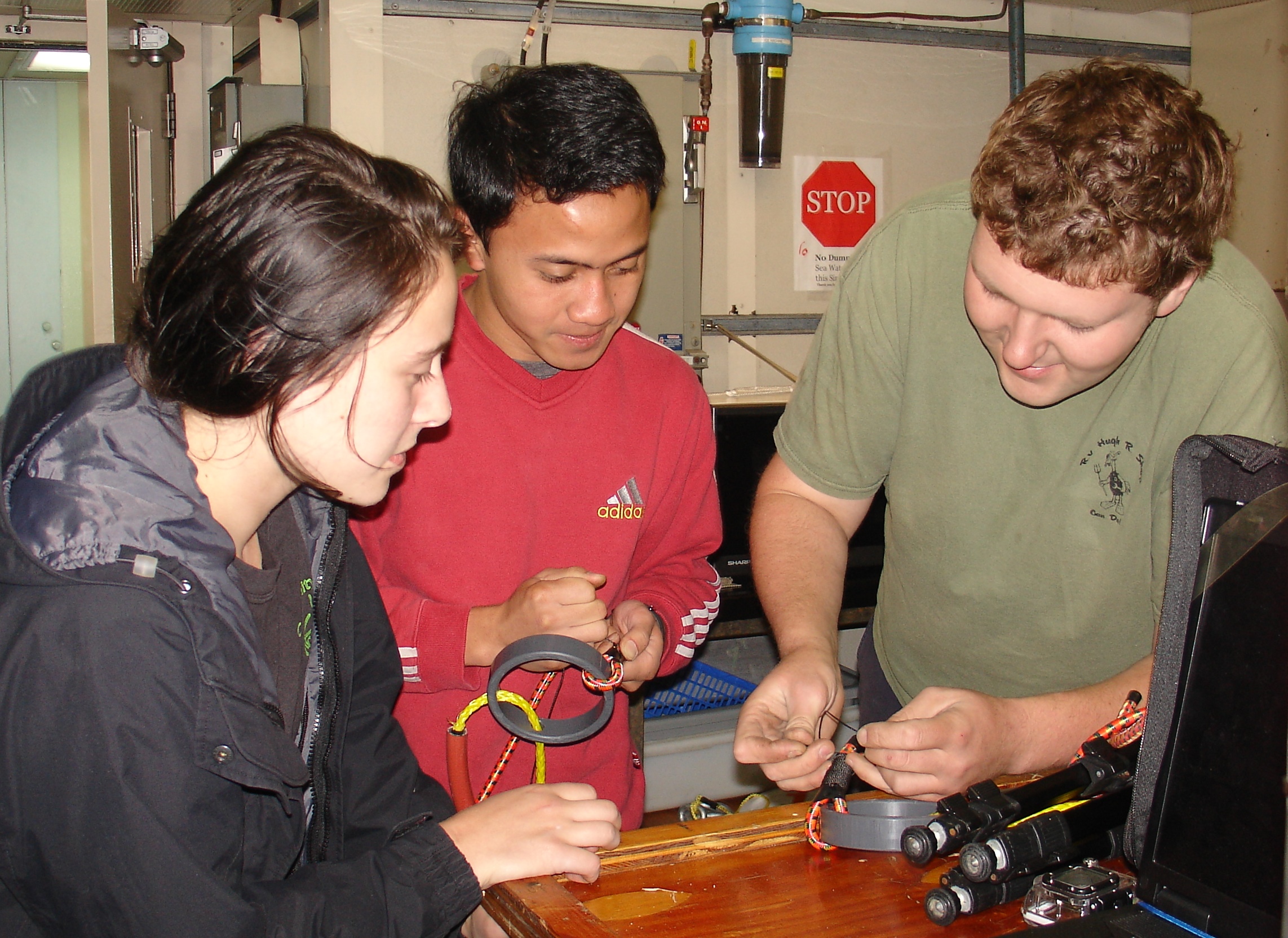Image Archive





























Diana successfully gets into a survivial suit during safety training on the first day of the Cabled Array VISIONS15 expedition. Credit: Mitch Elend, University of Washington, V15.

Kearstin, Malea, and Jessica peer out from behind immersion suit hoods during survival suit practice. Credit: Mitch Elend, University of Washington.

Undergraduate students from the UW School of Oceanography practice getting into emergency immersion suits during the first leg of the Cabled Array VISIONS'15 cruise. Credit: Mitch Elend, University of Washington.

Jesse Turner, UW School of Oceanography senior, prepares a zoonplankton net to sample organisms in the deep sea as part of the VISIONS15 program. Credit: Mitch Elend, University of Washington

UW undergraduate students Jessie and Diana happy to be onboard the R/V Thompson as we depart Seattle for the Ocean Observatories Initiative Cabled Array cruise 2015. Credit: Mitch Elend, University of Washington.

Preparing to deploy the CTD Photo credit: Mitch Elend, RSN, UW, V14

Faubion Taylor gets to experience putting on a survivial suit the first day of Leg 4, VISIONS'14. Photo Credit: Mitch Elend, University of Washington. V14.

Leg 3 students on the VISIONS'14 Expedition gather on the bow of the R/V Thompson. Photo Credit. Mitch Elend, UW; V14.

Kendra Daly, a Project Scientist on RSN and a Co-Chief Scientist on the VISIONS'14 Expedition processes water samples that were taken adjacent to a Deep Profiler. Photo Credit. E. McNichol, © 2014 Mumbian Enterprises, Inc; V14.

Eleven students from the University of Washington, University of Oregon, and Boston University are participating on Leg 2 of the VISIONS'14 expedition as part of the School of Oceanography experiential learning course 'Ocean 411'. Also shown is John Delaney (Chief Scientist - University of Washington) and Kendra Daly (Co-Chief Scientist - University of South Florida). Photo Credit: Ed McNichol, University of Washington, and Mumbian Enterprises; V14.

Kate Cox-Ebert is at Poulsbo Middle School where she is currently teaching Science, Mathematics, and Art.

During the evening of July 28th, the Main Lab of the R/V Thompson was filled with the Science and ROV Teams watching the live test of the HD video camera at the ASHES vent on Axial Seamount. The camera had not been turned on for 1 year. The test was a resounding success. Photo Credit: Mitch Elend, University of Washington; V14.

The integrated team of UW School of Oceanography Science (Giora Proskurowski), APL- Engineering (Dana Manalang and Trina Litchendorf), and undergraduate student (Christina Ramirez) help ready the digital-still camera for installation in the International District Hydrothermal Field. Photo Credit, Mitch Elend, University of Washington; V14.

Giora Proskurowski, a Project Scientist with the UW RSN Team, prepares a Remote Access Fluid Sampler (front) and microbial DNA sampler for installation in a diffuse flow site at the vent called 'El Gordo' in the International District hydrothermal field. The instrument is designed by Dr. David Butterfiled and NOAA-PMEL and the UW. Image Credit: Mitch Elend, University of Washington; V14.

The entire crew turns out for hand spooling ~800 ft of extension cable back onto the ROCLS drum that was recovered from the seafloor. Hard work, but lots of smiles. Photo credit: Mitch Elend, University of Washington, V14.

University of Washington undergraduate students learn how a CTD works, the science behind this instrument package, and how to take water samples during the VISIONS'14 expedition. Image Credit: Mitch Elend, University of Washington; V14.

VISIONS'14 undergraduate students use the bow of the R/V Thompson for their outdoor study session. Image Credit: Leslie Sautter, College of Charleston; V14.

Leg 1 University of Washington participants Skip Denny, Katie Bigham and Sam Albertson watch ROPOS' progress during dive R1716. Each action viewed and recorded on HD video must be carefully logged and documented with still photographs. Photo credit: NSF-OOI/UW/CSSF; Dive R1716; V14.

John Wonderly, from Clallam Bay school, collects fluid samples during the VISIONS14 expedition. Photo Credit: Mitch Elend, University of Washington; V14.

Gina Hansen, University of Washington Bioengineering student, helps takes water samples collected at ~ 9000 ft beneath the ocean's surface near Axial Seamount (volcano). Photo Credit: Mitch Elend, University of Washington, V14.

Keith Shepherd, Operations Manager for the Canadian Scientific Submersible Facility, oversees the lauch of ROPOS for Dive R1713. Photo Credit: Mitch Elend, University of Washington; V14.

Leg 1 students assist ship's crew to deploy the CTD. Photo credit:

The Conductivity, Temperature and Depth (CTD) probe lies within a large carousel of Niskin water bottles. The carousel is lowered to the seafloor while the CTD makes measurements. On the 'ride' up, a person on deck triggers the water bottles to close (one at a time) to collect a water sample at different depths. Photo credit: Mitch Elend, University of Washinton, V14.

Ben Brand (Univ. of Washington) teaches UW students Don Setiawan and Krista Nunnally to prepare the bungie cords used to tie down the spooled cable's end to the outer part of the ROCLS frame. O-rings provide an easy grab for the ROV's manipulator arm. Photo credit: Leslie Sautter, College of Charleston, V14.

University of Washington, School of Oceanography students watch the first CTD operation on the R/V Thompson. Here, they learn how to safely handle lines, sample ocean water, and conduct analyes onboard once the CTD returns to the deck. Photo Credit: Mitch Elend, University of Washington, V14.

Gina looks out toward the control room wall of monitors, watching ROPOS work near the seafloor.

Krista Nunnnally, Gina Hansen, and Don Setiawan watch ROPOS operations in the ROPOS control room during Dive R1712. Photo Credit: Mitch Elend, University of Washington, V14.

Katie Bigham on the R/V Thompson awaiting the ship's departure from Pier 90 in Seattle. Photo Credit: Mitch Elend, University of Washington, V14.
- Anemone
- Animal
- Arthropod
- ASHES
- Axial
- Axial Base
- Axial Biology
- Axial Caldera
- Bacteria
- Basalt Lava
- BEP
- Biofouling
- biolgoy
- Biology
- Camds
- Camera
- Camhd
- Central Caldera
- Ciliates
- Cnidaria
- Coastal Biology
- Crab
- Deep Profiler Mooring
- Dive Highlights
- Eastern Caldera
- Echinoderms
- Endurance Array
- Engineering Team
- ENLIGHTEN 10
- Exploratorium
- Fish
- Geology
- HD Camera
- HPIES
- Hydrate Ridge
- Hydrates
- Hydrophone
- Hydrothermal Vents
- Illustration
- Inshore 80 Meters
- Instrument
- International District
- J-BOX
- Jason
- Jellyfish
- Junction Box
- K12
- Lava
- Mollusk
- Moorings
- Nodes
- Nudibranch
- Octopus
- OOI
- Oregon Offshore
- Oregon Offshore 600 m
- Oregon Shelf
- Oregon Slope Base
- People
- PN1B
- PN1D
- Polychaetes
- PPSDN
- Primary Node
- RASFL
- ROCLS
- ROPOS
- ROPOS Dives
- ROV Team
- RV Revelle
- RV Sikuliaq
- RV Thompson
- Salp
- Sample
- SC13
- Science Team
- Sea Cucumber
- Sea Star
- Sea Urchin
- Seafloor
- Seismometer
- Sensors
- Shallow Profiler Mooring
- Shark
- Shipboard
- Shore Station
- Slope Base
- Smoker
- Soft Coral
- Southern Hydrate Ridge
- Sponge
- Squid
- Students
- Students & Guest Participants
- Tmpsf
- Tubeworms
- VISIONS 11 Leg 1
- VISIONS 11 Leg 2
- VISIONS 11 Viewers
- VISIONS 13
- VISIONS 14
- VISIONS 15
- VISIONS 16
- VISIONS 17
- VISIONS 18
- VISIONS 20
- VISIONS 22
- VISIONS 23
- Visualization
